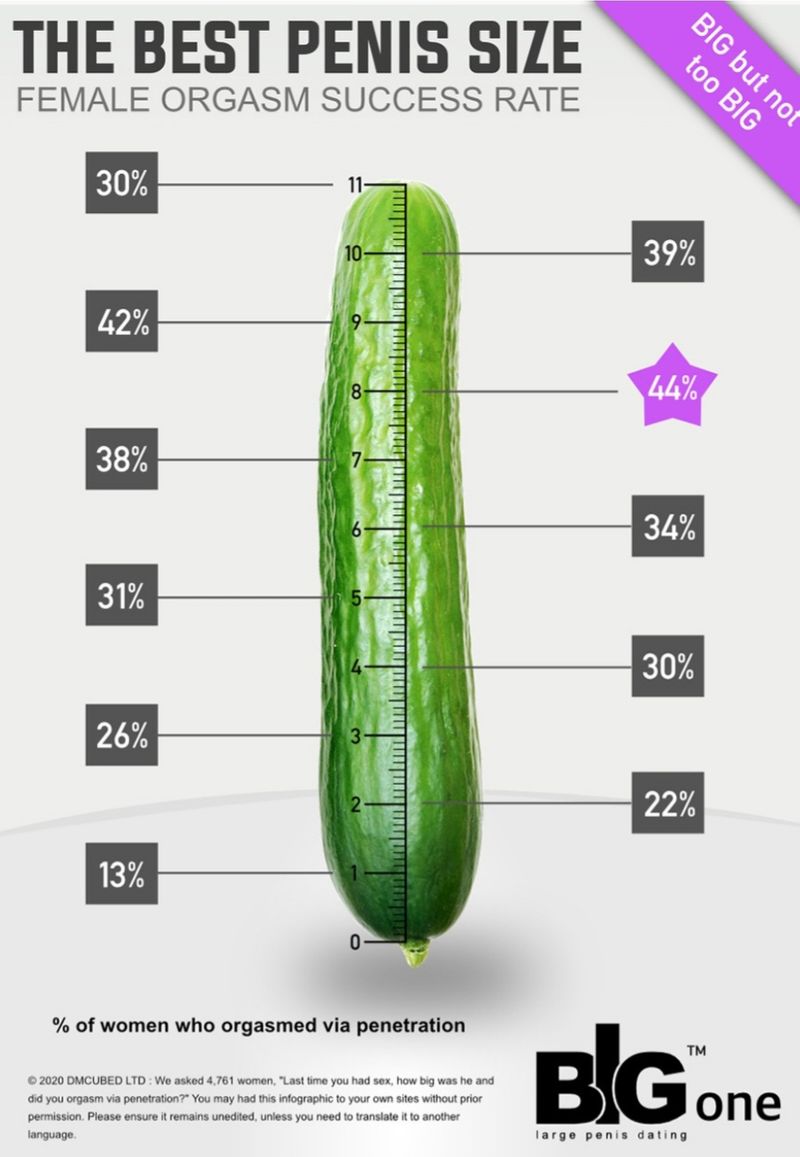Size and Orgasm Size Matter bed study shows
37899

Written by Dr.Deyn Natthakhet Yaemim, 24 March 2018
Medically Reviewed and updated by Dr.Deyn Natthakhet Yaemim, 31 May 2021
Women reach orgasm more easily when their lover’s manhood exceeds 5.8 inches, study shows
Concerns that men have about penis size may not solely stem from culturally imposed masculine stereotypes, but rather from a genuine understanding that size is important to many women.
Referred to as the "battle of the bulge," evidence suggests that size does matter in the bedroom.
Scottish psychologists conducted a study involving 323 women and discovered that most women find it easier to reach orgasm with partners whose penis size exceeds the average of 5.8 inches.
Researcher Stuart Brody, a psychologist at the University of West Scotland, explained to Live Science that this might be due to the ability of a longer penis to stimulate the entire length of the vagina and cervix. He noted that women who engaged with well-endowed partners reported the highest rates of vaginal orgasms.
Brody concluded, "Male anxiety about penis size may reflect a genuine awareness that size matters to many women, rather than just internalized cultural stereotypes."
Do Women Have More Orgasms if their Sex Partner has a Longer than Average Penis?
Many men are anxious about their penis size, and it is usual for men to desire a longer-than-average penis. But why should we care so much about the contents of our underpants?
Kim Drasa and Vaso Vasili, a pair of scientists from Tirana in Albania, wondered whether a man’s penis size influences the likelihood that his female sexual partners will achieve orgasm during penile-vaginal intercourse. If women prefer longer penises or are more orgasmic during sex with men whose penises are longer, this may explain why men are so concerned about the size of their manhood.
Drasa and Vasili surveyed 1275 sexually experienced women. Each woman was asked:
All things being equal, are you more likely to have an orgasm from penis-in-vagina intercourse with a man who has a somewhat larger-than-average penis length?
The women were told that an average erect penis was about the length of any US dollar bill (155mm) or a British £20 note (149mm).
As many as 35% of the women reported that they were more likely to experience an orgasm if their partner had a longer than average penis, but 56.5% of women said that they were equally likely to orgasm if a man had an average or above-average penis. Only 2% of women said orgasms were more frequent if a man had a penis of average size.
The researchers also found that a preference for a longer penis is associated with more frequent vaginal orgasms, but not more clitoral orgasms or orgasms after masturbation. This argues against an interpretation that women with a larger libido or unrestricted sexuality (interest in short-term sexual encounters) tend to prefer longer penises.
Nevertheless, it seems that penis length does affect women’s orgasm frequency, even if most women report that a longer penis does not necessarily guarantee more satisfying sex.
Something Fishy
In another research paper recently published in the journal Nature Communications, a team of biologists has shown that male genital size is even less important among fish.
Isobel Booksmythe of the Australian National University in Canberra led the study in which mosquitofish were selectively bred for gonopodia size. The gonopodium is a modified anal fin, and it’s the organ males use to inseminate females. Gonopodia vary in length much more than human penises, with some individuals boasting a gonopodium 53% as long as their body. Other, less well-endowed mosquitofish, only manage a gonopodium 18% of their body size.
The researchers found that males with longer gonopodia were no more alluring to females than males with shorter gonopodia. Given a choice, females spent just as much time associating with the well-endowed males as the less well-endowed males. Neither did gonopodium size affect reproductive success or swimming ability. However, previous research has suggested that male mosquitofish taken from predator-rich environments tend to have shorter gonopodia, suggesting that there are evolutionary consequences to sporting an over-sized member. A smaller ‘penis’ is a boon when it comes to the survival of the fish.
The Biggest-Ever Orgasm Study Tells Us More About How Women Come
A study published last month in The Journal of Sex and Marital Therapy found that nearly 37 percent of American women required clitoral stimulation to experience orgasm, compared with 18 percent of women who said that vaginal penetration alone was enough to come.
According to Debby Herbenick, a researcher at the Center for Sexual Health Promotion at Indiana University, the results of this study revealed women's wide range of preferences when it came to how they liked being touched during sex.
The study, which was conducted in partnership with OMGYes, a company focused on "the science of women's pleasure," surveyed more than 1,000 women between the ages of 18 and 94. The study followed on the heels of a round of 1,000 interviews conducted by OMGYes with different women about their sexual preferences, for a combined cohort of 2,000 participants to make this largest-ever study on the specifics of women's pleasure.
The women in the study took a survey composed of 30 multipart questions related to their sexual behaviors, attitudes, and experiences with genital touching, including detailed questions about how the women preferred to be touched. Nearly 37 percent of women responded that they needed clitoral stimulation to come, and another 36 percent responded that while they didn't require clitoral stimulation to orgasm, it did enhance the experience. Eighteen percent of respondents said vaginal penetration alone was sufficient for orgasm, and 9 percent reported that they didn't have orgasms during intercourse, or achieved orgasm in other ways, such as oral sex.
As for their subjective experiences of pleasure, a majority of women cited 'spending time to build-up arousal,' 'having a partner who knows what I like,' and 'emotional intimacy' as techniques that enhance their orgasms. As far as the actual touching, 66.6 percent of women said they preferred being touched directly on the clitoris and cited 'up and down' with medium pressure as their preferred style of touch.
The research adds some much-needed data to the science of women's pleasure, which has long been haunted by largely baseless Freudian assertions about the nature of female orgasms.
"Freud contended that the clitoral orgasm was adolescent and that upon puberty when began having intercourse with men, women should transfer the center of the orgasm to the vagina," the feminist Anne Koedt wrote in the famous 1970 essay, The Myth of Vaginal Orgasm. "The vagina, it was assumed, was able to produce a parallel, but more mature, orgasm than the clitoris. Much work was done to elaborate on this theory, but little was done to challenge its basic assumptions."
"The idea of one kind of orgasm being more mature is ridiculous," Herbenick says. "I also don't like the clitoral/vaginal orgasms binary because, anatomically, all of these parts are tiny and close to each other and packed. Ultimately I don't think fighting over which nerve endings led to the orgasm is instructive."
According to Herbenick, the reality of female orgasm is quite nuanced but there has historically been a large knowledge gap when it comes to the science of coming. As one of the first studies to address female orgasm in a nationally representative sample of women in the US, Herbenick and her colleagues' work represents an important step toward a broader understanding of women's sexual health.
"The first US nationally representative study of sexual behavior ever was conducted in the US was conducted in the early 1990s and our research team conducted the second one ever back in 2009," Herbenick said. "That's a gap of around 20 years before that had even taken place for a second time. Part of the reason sexual behavior studies aren't frequently conducted is because they're expensive and the federal government has never provided funding for one."
Moreover, prior studies on sexual pleasure in women have used limited sample sizes or didn't focus on specific details of sexual touch. This lack of subjective data on genital sensitivity makes empirical science focusing on neurological networks in the genitals more difficult and may also prohibit sex educators and clinicians from addressing common experiences or concerns among women when it comes to sexual health and pleasure, according to Herbenick and her colleagues.
Although the study is one of the most in-depth surveys on women's sexual pleasure ever conducted, Herbenick said several questions remain.
"I was intrigued that 41 percent of women just honed in on one style of touching they liked," Herbenick said. "In a future study, I think it would be fascinating to encourage those women to explore some other ways and see if they do just like one style or if there is a second one if they explore it they like."
Ultimately, Herbenick said the study points to the importance of communication and openness in the bedroom. "If that many people just prefer one thing, you have to talk to each other to find out what you like otherwise it's such a guessing game," Herbenick said. "As part of my teaching of human sexuality, I've always encouraged people to say just because you've found one thing you like, try not to limit yourself. I guess I'm still a big proponent of exploration."
Contact us at info.bkk@pulse-clinic.com or chat on your preferred platform:
![]() +66 65 237 1936
+66 65 237 1936  @PULSEClinic
@PULSEClinic ![]() PulseClinic
PulseClinic
Trust PULSE CLINIC to take care of your health like other 45000 people from over 130 countries. We provide discreet professional service with high privacy. Here to help, not to judge.

Trust PULSE CLINIC to take care of your health like other 45000 people from over 130 countries. We provide discreet professional service with high privacy. Here to help, not to judge.
Loading...
Clinic Locations
Loading...

